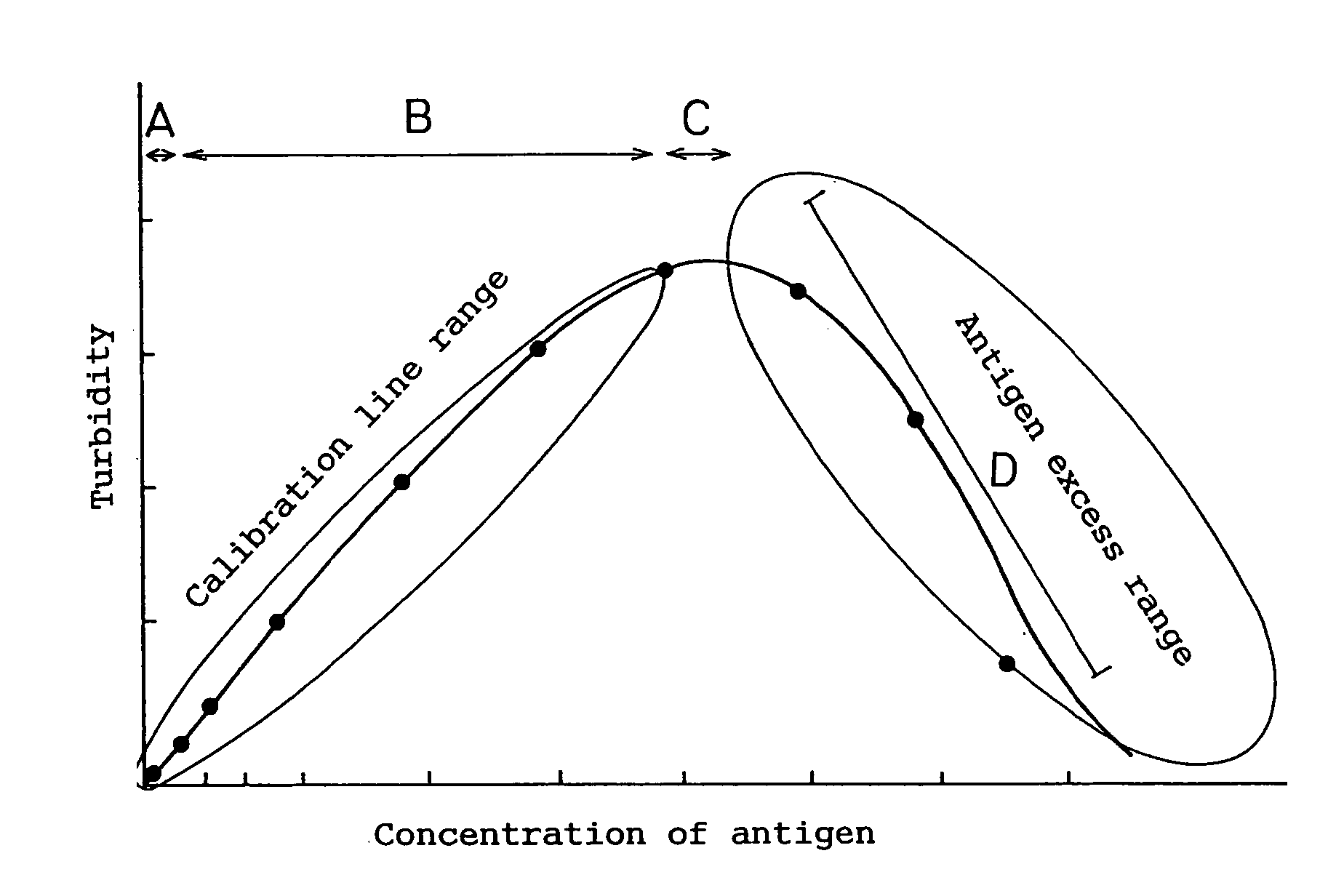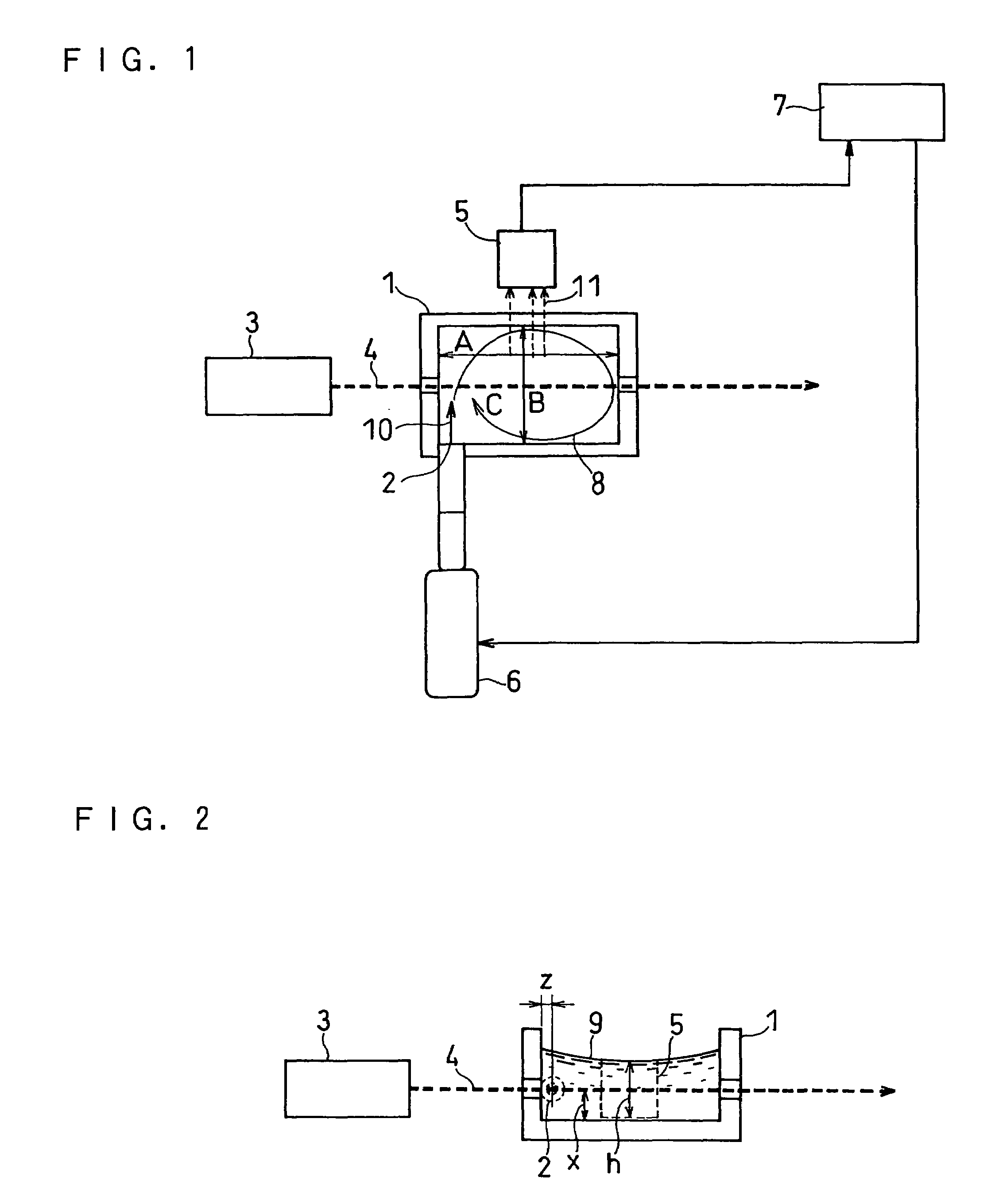Turbidimetric immunoassay and an apparatus therefor
a technology of turbidimetric immunoassay and apparatus, which is applied in the direction of optical radiation measurement, instruments, spectrometry/spectrophotometry/monochromators, etc., can solve the problem of increasing the turbidity of the sample solution, and achieve the effect of expanding the measurable concentration rang
- Summary
- Abstract
- Description
- Claims
- Application Information
AI Technical Summary
Benefits of technology
Problems solved by technology
Method used
Image
Examples
embodiment 1
[0079]This embodiment is an example of determining the concentration of albumin in urine by using a monoclonal antibody that specifically binds to human serum albumin and urine as the sample solution.
[0080]In turbidimetric immunoassay, it is crucial that an antigen and an antibody be aggregated by an antigen-antibody reaction. In other words, an antigen and an antibody should bind each other to produce bound substances, which are cross-linked between antibody molecules of the bound substances to produce larger particles (antigen-antibody complex). Accordingly, at least two different antibodies having different binding sites on the antigen are necessary.
[0081]The antigen-antibody complex should have a particle size enough to indicate the maximum or minimum value of the measured turbidity level. The size varies depending on various conditions, but preferred is about not less than 25 μm.
[0082]For this reason, a polyclonal antibody is typically used in turbidimetric immunoassay. It has ...
embodiment 2
[0104]A description is given of a second embodiment according to the present invention referring to FIG. 15. In this embodiment, an example of determining the concentration using FIGS. 15 and 16 is shown.
[0105]When the maximum value of the turbidity level is 5.5, for example, it is difficult to identify, from FIG. 15 only, whether the sample solution has a concentration of either about 30 mg / dl or 150 to 250 mg / dl, but with the use of FIG. 16 in addition to FIG. 15 the concentration can be identified and determined. To be more specific, if the elapsed time when the maximum value is observed (Tpeak) in this case is about 35 seconds, the concentration can be determined to 30 mg / dl. If the elapsed time when the maximum value is observed (Tpeak) is about 18 seconds, the concentration can be determined to 150 to 250 mg / dl.
[0106]As just described, the concentration can be unambiguously determined from the correlation between the maximum value (Speak) of the turbidity level after a certain...
embodiment 3
[0108]A description is given of a third embodiment according to the present invention referring to FIG. 16. As seen from FIG. 16, when the elapsed time when the maximum value is observed (Tpeak) is not less than a given value T0 (T0≈18 seconds in FIG. 16), the concentration can be unambiguously determined from the Tpeak only. To sum up, when the elapsed time (Tpeak) is not greater than a given value T0, the concentration can be determined to be equal to or greater than a given value C0 (C0 is 100 mg / dl in FIG. 16). Conversely, when the elapsed time (Tpeak) is not less than a given value T0, the concentration can be found from FIG. 16, in other words, it can be determined according to Tpeak in FIG. 16. This embodiment is also more advantageous than EMBODIMENT 1 in speeding up the measurement because the concentration can be determined right after the maximum value of the turbidity level is detected.
[0109]In the case where the concentration is so low that the maximum value does not ex...
PUM
| Property | Measurement | Unit |
|---|---|---|
| inner diameter | aaaaa | aaaaa |
| diameter | aaaaa | aaaaa |
| wavelength | aaaaa | aaaaa |
Abstract
Description
Claims
Application Information
 Login to View More
Login to View More - R&D
- Intellectual Property
- Life Sciences
- Materials
- Tech Scout
- Unparalleled Data Quality
- Higher Quality Content
- 60% Fewer Hallucinations
Browse by: Latest US Patents, China's latest patents, Technical Efficacy Thesaurus, Application Domain, Technology Topic, Popular Technical Reports.
© 2025 PatSnap. All rights reserved.Legal|Privacy policy|Modern Slavery Act Transparency Statement|Sitemap|About US| Contact US: help@patsnap.com



